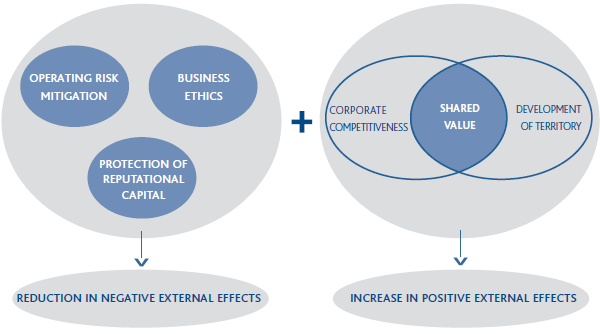
New identity and visibility: sustainability as an opportunity
Snam has begun a process of reflection geared toward combining consolidation of the path undertaken (control of risk factors) with a new strategic impetus that allows for positioning Snam among the key players in the country’s development. Even before taking on an operational dimension, corporate sustainability can be a logical and conceptual identity framework within which the change under way is possible. This is where Snam wishes to start from in further strengthening its positioning on the market. This is where the process of reflection on Snam’s new sustainability approach starts, from the standpoint of the continual improvement that characterises the Company’s DNA: the creation of shared value.
The shared value approach explores the link between the economic system and the Company. A company’s development also depends on the quality of the local areas in which it operates (availability of raw materials and human capital, market conditions, domestic demand, etc.).
The players operating within the territory may in turn create conditions for a context favourable to business development. A healthy social and local context also depends on the presence of companies that are capable of providing jobs, paying adequate wages and salaries, purchasing quality goods and services, paying taxes, protecting the environment, using resources efficiently, etc.
Snam and Sustainability 2.0: the change in relations with stakeholders toward the creation of value
Why does Snam, one of Italy’s top companies, intend to start on a path toward the creation of shared value? The Company has always considered sustainability vis-à-vis all stakeholders to be an integral part of its business model. It is a lodestar in defining strategic and operational choices and a lever for ensuring sustainable growth over the long term, at the same time guaranteeing that the value generated will be shared with all of its stakeholders. Snam plays a key role in energy supply and continues to make a contribution to the country’s economic and social development, operating as a natural monopoly in an area of public interest.

Snam’s operational assets and personnel are distributed throughout a large part of the nation’s territory. The tangible and intangible assets of Snam, put the Company in a privileged position to develop and increase Sustainability 2.0, integrating the “risk mitigation” approach, which is necessary to reduce and control risks, with the concept of shared value, which is fundamental to affording a competitive advantage to the Company and to the local areas in which it operates.
This approach will support the change that the Company will experience in the coming years with a new process of reflection on Snam’s contribution to sustainable development, the country’s competitiveness and the ongoing development of the communities and local areas in which it is present and operates.
SUSTAINABILITY 2.0

Sustainability for a competitive advantage
Snam is capable of creating development opportunities for itself and for the stakeholders with which it interacts, allowing it to increase the competitiveness and speed of innovation processes. Sustainability is a model of responsible corporate conduct vis-à-vis stakeholders aimed at maintaining the “licence to operate” and at protecting reputational capital. Sustainability is a development model based on corporate leadership in interacting with the social context in question, aimed at creating opportunities to create and share value. Sustainability is a key factor for acquiring a competitive edge through the expression of leadership, including culturally, on key topics and a strong drive toward innovation.
Three key questions
Starting in the pages of the 2010 edition of the Sustainability Report, the Company began a first draft of reasoning on the subject of shared value, asking itself three key questions for purposes of understanding to what degree sustainability strategies are rooted in the Company. Firstly: do sustainability policies inform all activities throughout the Company’s chain of value, beginning with the most critical ones, considering the specific nature of the business? Secondly: is attention to sustainability seen only in a defensive mode – in the sense of “protecting value”, for limiting operational and reputational risks – or does it become a source of “creation of value”, as a driver of innovation? Lastly, the third question: does the Company contribute, by self-governance and by participating in defining the rules implemented by lawmakers and public authorities, to designing a system of governance capable of ensuring fairness and efficiency in general? Being players in true sustainable growth implies being able to answer these three questions in the affirmative.

“Creating Shared Value”, by Michael E. Porter and Mark R. Kramer
The shared value approach, conceived by Michael Porter, professor at Harvard Business School, where he directs the Institute for Strategy and Competitiveness, in collaboration with Mark Kramer, senior fellow of the CSR Initiative at Harvard’s John F. Kennedy School of Government in Cambridge, Massachusetts, explores the link between the economic system and society. The concept, published for the first time by the Harvard Business Review in January 2011, is based on the assumption that, in light of the recent financial and economic crises, capitalism is under attack and therefore it is necessary to identify a new model capable of reinventing it.
The starting point is that no company is an isolated entity. The success of all companies is influenced by the support services and infrastructure surrounding them; productivity and innovation are strongly influenced by the logistical infrastructure of a given local area. A company’s development therefore depends on (the quality and quantity of) domestic demand. Players operating in a local area can create conditions for a context favourable to business development. On the other hand, a healthy social and local context depends on the presence of companies that are capable of providing jobs, offering adequate salaries and wages, acquiring quality goods and services, paying taxes, protecting the environment, using resources efficiently, etc.
Companies, says Porter, must act to reconcile business and society, and the path to go down is that of “creating shared value”, i.e. creating economic value in such a manner as to generate value at the same time not only for the Company, but also for society, simultaneously meeting the Company’s needs and needs of a social nature. It is a new point of view that involves making the most of company know-how and reconfiguring relations throughout the value chain.
Companies can create shared value in three different ways, writes Mark Kramer: re-conceiving new products and markets; redefining productivity in the value chain; and building industry clusters to support society’s competitiveness.
The concept of shared value in a certain sense includes the idea of social responsibility applied until now: it serves as an innovative approach to sustainability that sees social growth as a central and not an ancillary objective, write the authors. “CSR programmes focus mainly on reputation and have only a limited connection to business, which makes them difficult to justify and maintain over the long term. On the other hand, the Creation of Shared Value (CSV) is functional to profitability and to a company’s competitive position. It makes use of a company’s specific resources and specific expertise to create economic value through the creation of social value”.




